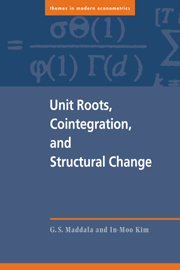Book contents
- Frontmatter
- Contents
- Figures
- Tables
- Dedication
- Preface
- Part I Introduction and basic concepts
- Part II Unit roots and cointegration
- Part III Extensions of the basic model
- Part IV Structural change
- 13 Structural change, unit roots, and cointegration
- 14 Outliers and unit roots
- 15 Regime switching models and structural time series models
- 16 Future directions
- Appendix 1 A brief guide to asymptotic theory
- Author index
- Subject index
15 - Regime switching models and structural time series models
Published online by Cambridge University Press: 04 August 2010
- Frontmatter
- Contents
- Figures
- Tables
- Dedication
- Preface
- Part I Introduction and basic concepts
- Part II Unit roots and cointegration
- Part III Extensions of the basic model
- Part IV Structural change
- 13 Structural change, unit roots, and cointegration
- 14 Outliers and unit roots
- 15 Regime switching models and structural time series models
- 16 Future directions
- Appendix 1 A brief guide to asymptotic theory
- Author index
- Subject index
Summary
In the previous two chapters we considered some methods of an analysis of structural change. In this chapter we shall discuss regime switching models of which the widely used Markov switching model is a special case. We also discuss several extensions of the Markov switching model. This model implies sudden switches. More reasonable models are gradual switching models – Harvey's structural time series model being a special case. These models are also known as state-space models.
We shall discuss the main ideas and the problems these models try to solve. We omit the detailed mathematics, which is quite involved, because we do not see any point in reproducing it from the papers cited. Those interested in the details can refer to the particular paper relevant for their work, on which they can decide from our review. We feel it is important to understand the merits and limitations of the different procedures before getting bogged down in the mathematical detail.
The estimation problems with the Markov switching models are not as complex as those of testing. An illustration of the problems of testing is the paper by Garcia (1997) which has been around for many years in its several unpublished versions.
The switching regression model
A commonly used model for the analysis of structural change is the switching regression model. This model was first introduced into the econometric literature by Quandt (1958), though it has a long history (see Lindgren, 1978).
- Type
- Chapter
- Information
- Unit Roots, Cointegration, and Structural Change , pp. 454 - 485Publisher: Cambridge University PressPrint publication year: 1999



